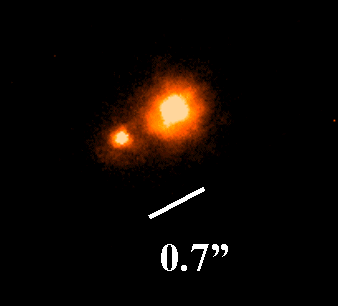The Gemini-North telescope in Hawaii took its first images of the sky earlier this week. Its twin, the Gemini-South telescope in Chile, is expected to come on-line in 2001. The telescopes will give high-quality simultaneous coverage of the northern and southern skies at infrared and optical wavelengths. Each telescope will be able to collect 10 times as much light as the Hubble Space Telescope, and will be able to distinguish between two points of light separated by less than tenth of an arc second in the sky. The total cost of the telescopes will be about $190m.

Gemini-North is situated on top of Mauna Kea, an extinct volcano some 4200 meters above sea level. Mauna Kea is a popular location for telescopes because of its high altitude and clear skies. The 8-meter Gemini telescopes are the latest in a new generation of large telescopes that already includes the two 10-metre Keck telescopes in Hawaii, the 8-metre Subaru telescope, also in Hawaii, and the Very Large Telescope, a set of four 8-metre telescopes in Chile. Two of the four telescopes in the VLT have been completed.
The Gemini telescopes will allow astronomers to view the faintest and most distant objects in sky at near infrared wavelengths, where stars are not obscured by vast interstellar dust clouds. “Astronomy is about origins,” says Malcolm Longair of Cambridge University, a member of the governing board of Gemini. “We want to study the origins of the universe, the origins and galaxies, stars and planets and even the origins of life itself.”
Observing time on the telescopes will be split between the Gemini partners according to their financial contribution to the project. The breakdown will be: US 47.6%, UK 23.8%, Canada 14.3%, Australia 4.8%, Chile 4.8%, Argentina 2.4%, Brazil 2.4%. Over the next five months, Gemini scientists will calibrate and test the instruments on the telescope, and will announce in November which instruments are available for the start of observations in January 2000. Gemini managers will use a procedure called Q-mode observing to ensure that the instrument best suited for observations at a particular time is used. For example, if weather conditions change so that they are more favourable for observations in the near-infrared as opposed to the visible, the telescope will switch to near-infrared instruments.
In common with other large telescopes and radio telescopes, Gemini will have to live with interference from satellites in low-Earth orbits. These satellites interfere with the lasers used by Gemini to operate its “active optics” system, which allows it to make corrections for the effects of atmospheric turbulence on observations. “It’s a growing problem,” says Gemini project director, Matt Mountain.



